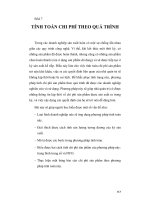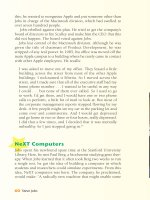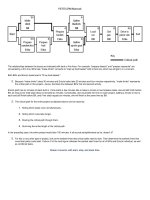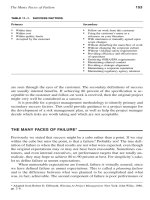Crisis Management phần 7 ppsx
Bạn đang xem bản rút gọn của tài liệu. Xem và tải ngay bản đầy đủ của tài liệu tại đây (67.61 KB, 9 trang )
54 CRISIS MANAGEMENT
KEY LEARNING POINT
It took guts for Pepsi to hold off making a public announcement
until it was fully ready to do it. It showed a lot of internal confidence
in the safety of the company’s production process. And it paid off.
The dip in sales of Diet Pepsi that had occurred during the syringe
crisis was more than offset by the increase that took place in the
months following the tampering incidents.
JACK-IN-THE-BOX AND THE BAD MEAT
This company, operating fast food outlets, principally in the Pacific
north-west, was shaken badly by an outbreak of food poisoning
thatcamefromhamburgerseatenbymanyofitscustomersduring
January 1993.
There were a lot of sick stomachs, some 800 of them. Included
in that number were 3 deaths and 144 people who were admitted to
hospital. One child died as a direct result of the bad meat. The first thing
that the company did, quite naturally, was to stop selling hamburgers
in the area from which the complaints had originated.
Several days after the first reports of sickness had been received,
and as more came in, the president of Jack-in-the-Box, Robert Nugent,
appeared at a company news conference held in Seattle. He offered his
hopes that everyone who had gotten sick from the hamburgers would
recover and admitted that the problem lay in contaminated meat.
Thecompanytriedtogetaheadofthestorywiththeadmission
that the meat was bad. But its contention that there was no fault on
the part of Jack-in-the-Box was shaky from the start. One problem
was that the company had been charged by the Washington State
Health Department of being in violation of established safety and
healthy-cooking procedures, regardless of whether or not the meat was
contaminated.
It was the company’s claim that a meat supplier provided the
contaminated beef and that the State of Washington, which had charged
the company with violating its health regulations, hadn’t told Jack-in-
the-Box about the recent changes in those state-established regulations.
Specifically, Nugent said to the assembled media:
IN PRACTICE 55
‘‘While the Washington State Health Department recently, and
we think appropriately, upgraded their temperature regulations
for hamburgers, it is clear that Jack-in-the-Box was not properly
informed of this change.’’
As things turned out, that statement was untrue and Jack-in-the-Box
would pay the price for it.
No government agency, at any level, is going to become the bad guy
in this kind of a situation and, if there was ever one thing to remember
about bureaucrats, they do tend to keep records. True to the statement,
the people in the Washington State Health Department had theirs.
And so, as they say, it came to pass that when the annual meeting
of Jack-in-the-Box was held some weeks later, and when the bad meat
stories were rapidly fading from the front pages, Nugent was forced
to make a damaging admission. The new regulations had, in fact, been
received and were on file both at the company’s home office and in
the Tacoma, Washington site where the offending hamburgers were
cooked.
The end result was, indeed, a dismal one. The value of the
company’s shares fell like stones off a cliff and the lawsuits against
Jack-in-the-Box multiplied. Faced with the effects of two crises, the
first involving the bad meat and the second in giving out what
proved to be false information about the receipt of health depart-
ment regulations, Jack-in-the-Box did what it could in terms of damage
control.
It settled the lawsuits, a good tactic whenever possible since court
battles generally mean even greater and, from the point of view of
a corporation versus a consumer, negative news coverage. Jack-in-
the-Box also engaged in a major program, through media advertising
and distributed literature, to inform the public about what it was
doing to make things right for the victims and their families. One
key element of the campaign was the statement by Robert Nugent
who said:
‘‘We are committed to meeting all of our responsibilities in connec-
tion with this devastating situation. We are prepared to pay all
hospital costs for our customers who have been affected by this
tragedy.’’
56 CRISIS MANAGEMENT
KEY LEARNING POINT
Despite efforts to pay the hospital bills of the affected customers
and a campaign of advertising designed to rebuild its customer
base, Food Maker Inc., the Jack-in-the-Box corporate parent,
suffered badly in the eyes of its shareholders and the public
in general. When a company gets ahead of a developing story in a
crisis, it must have all the facts. Food Maker didn’t.
GERBER AND THE GLASS
Glass pieces in baby food? The allegation was loud and totally without
basis in truth. Sometimes, too often, as in both the Pepsi-Cola and
Gerber cases, the truth gets lost in the media glare and the consumer
advocacy frenzy.
The first report about the glass came from up-state New York in
February 1986 where a woman said she had found glass in a jar
of the company’s baby food. Upon learning of the claim, Gerber
obtained the jar and others bearing the same product identifica-
tion code and rushed all of them to the company’s lab for testing.
The New York State Health Department did the same analysis at the
same time.
And then the media jumped in, at one time reportedly asking
shoppers if they knew that the baby food might be contaminated with
glass. And that was enough for some government leaders who just
might have had their own obvious agendas. The Brooklyn, New York
District Attorney talked about a possible criminal investigation and
the governor of Maryland ordered Gerber’s strained peaches off retail
shelves in that state.
Gerber took the position that it was the victim and acted accordingly.
As both its own tests and those of everyone else showed the baby food to
be without any trace of glass, the company moved forward. It launched
a major media blitz that included both the local and national news
outlets; it responded to every media inquiry about every complaint;
it reached out to consumers in its advertising and via mailings; and it
asked for, and got, support from the FDA about its production safety
procedures.
IN PRACTICE 57
Not only were the media, the government, and customers targeted
by the company, so were the retailers who stocked Gerber prod-
ucts, shareholders, and employees. Full, continuous communication,
specifically tailored to meet the needs of the company’s publics, was
critical.
KEY LEARNING POINT
The results of the efforts were highly positive, a point best illus-
trated by a rise in product market-share over the level that existed
before the crisis.
PANAM AND LOCKERBIE
The terrorist bombing that blew PanAm Flight 103 out of the sky over
Lockerbie, Scotland, on the night of December 21, 1988, resulted in
the deaths of 270 people and effectively ended the corporate history
of the original PanAmerican World Airways.
The story of the bombing itself has become a major part of history,
with much wider applications that involve geopolitics, international
tensions, and the workings of international justice. But the case has
also generated important points for consideration by people who are
interested in, and responsible for, crisis management in a more limited
sense. Given the nature, the inherent drama, and the sickening aspects
of the unnecessary tragedy, it is vital to examine what the airline did
and did not do in the hours and days that followed the crash.
The airline’s first word of the crash was received from wire-service
reporters and the only available confirmation was that the plane had
dropped off the radar screens. Soon afterwards, PanAm was able to
confirm the crash, as did the Federal Aviation Administration (FAA),
although the first reports as to the number of passengers and the cause
of the disaster were incorrect.
At the beginning of the crisis, the airline took steps that it should
have taken, including setting up a dedicated telephone line for the
relatives and friends of those who were known to have been aboard
the downed plane. As part of the company’s well-designed crisis plan,
teams of PanAm employees were created to deal with the anguish
58 CRISIS MANAGEMENT
of those who had lost loved ones. The company’s offices in the
PanAmerican building in New York were sealed off to permit effective
crisis management operations. And then the airline went public to
discuss the aircraft, a 747 Boeing jet, how it was built, specifics of its
maintenance record, and its proven structural soundness.
The first news conference was held in the early evening at the
PanAm offices. By that time, the correct passenger (and thus fatality)
count was available and given to the assembled media. As required by
the company’s standard operating procedures, no names of passengers
were divulged pending notification of the next of kin.
Despite being pushed by reporters as to the cause of the crash,
PanAm spokesman Jeff Kriendler refused to speculate on that point
despite the growing feeling that there was something more than a
tragic crash involved. In fact, less than an hour after the plane went
down, experts in the US and the UK knew that the crash was caused
by an act of terrorism.
The initial handling of the crisis on the part of PanAm has to be
considered as excellent. The well-designed and rehearsed crisis plan
that had been developed by the airline functioned well. But there would
prove to be a problem that the crisis managers could not control.
The day after the crash, the news media learned that several weeks
earlier, the FAA had advised a number of government agencies that
an anonymous threat had been received by the American embassy in
Helsinki, Finland, that a PanAm flight from Frankfurt en route to the
US would be bombed. While it was later shown that the threat had
no connection to the actual bombing, the fact that the airline had not
warned its passengers became another public relations problem.
From a historical view it is interesting to compare the firestorm
reaction of the families of victims in this case to the far more restrained
one that occurred after the liner Lusitania wassunkbyaGerman
U-boat in 1915. There is a close similarity, based on the warning posted
by the German embassy in New York before the ship sailed that it
was considered to be a legitimate target. Cunard, the ship’s owner, did
nothing affirmatively to warn passengers, about 1200 of whom died off
the Irish coast.
Several weeks later, PanAm CEO Thomas Plaskett flew to the UK
to attend a memorial service for the victims of the bombing. Despite
IN PRACTICE 59
that, there was criticism from the public about the fact that he had not
flown to the crash site immediately after the disaster. There was also a
continuing chorus of criticism from people who claimed that PanAm
should have told passengers about the threats that had been received
by the US government in the days before the bombing.
KEY LEARNING POINT
Despite all of the things that PanAm did right during the crisis,
the incident was clearly one of several factors that put the carrier
out of business. Because of these other reasons, which were
essentially financial, the full impact of the incident and the long-
term effectiveness of the crisis management actions that were
taken, will never be known. When an incident occurs that is totally
beyond the ability of an organization to prevent, and when there
are other major factors in the mix, including financial performance,
effective crisis management may not be enough to keep the
company going as a viable entity. Without such management,
however, its demise is virtually guaranteed.
THE EXTRA STRENGTH TYLENOL POISONINGS
There is probably no debate about the fact that this case is the one most
remembered and cited by crisis management consultants, executives,
and academics. The essential facts are well known. In late September
and early October 1982, six people died as a result of swallowing
Extra Strength Tylenol capsules that contained cyanide. Extra Strength
Tylenol was a major product marketed by Johnson & Johnson, a highly
respected company with headquarters in New Jersey.
An investigation into the deaths, led by the Federal Bureau of
Investigation, began with the full co-operation of the company. It was
clear from the beginning that the cyanide used in the murders had not
been placed in the capsules at the company’s facilities, although one
early problem occurred when the company first stated that it didn’t
use cyanide in any manufacturing process. The company was forced
to correct that statement – a fact that caused some temporary loss of
corporate credibility.
60 CRISIS MANAGEMENT
Despite that knowledge, Johnson & Johnson took the capsules off the
market and sent warning letters to hospitals, doctors, and pharmacists
about the problem. In addition, all product advertising was immediately
halted.
Thepointpersonforthecompanyinthiscrisiswasitschairman,
James E. Burke, who earned much-deserved credit for his actions
and personal leadership. Burke ordered the worldwide recall of Extra
Strength Tylenol at a cost to the company of roughly $100mn. He
authorized a $100,000 reward for the arrest and conviction of the
killer and supervised a program that offered to exchange money for
capsules that were in the hands of consumers. Finally, he ordered a
major communications effort, using both advertising and publicity, to
calm the public and to retain the confidence of customers and other
target groups.
One important part of the Johnson & Johnson program was to have
a national opinion survey conducted. The point of the survey was to
determine the public’s view about Tylenol and thus to assess the level
of damage that had been sustained as a result of the crisis. The results
were disturbing. According to the survey, approximately 87% of the
people queried believed that the company had no responsibility for the
cyanide incident. On the other hand, 61% said they would not buy the
product.
The position of the company was set out by Burke, who said: ‘‘It
is our job at Johnson & Johnson to ensure the survival of Tylenol
and we are pledged to do this.’’ A new tamper-resistant package for
the product was designed and introduced. But tamper-resistant is not
tamper-proof. By the end of 1982 the company’s market-share had been
largely restored but corporate happiness was to be short-lived.
In February 1986 another fatality was reported and, once again, the
capsules were taken from the shelves. This time the cost was estimated
to be $150mn. The capsules were then taken out of production and
replaced with caplets. At that time a much disappointed Burke noted:
‘‘I’m heartsick. We didn’t believe it could happen again and nobody
else did either.’’
The end of the cyanide crisis and its handling by Johnson & Johnson
marked the establishment of Burke as a modern corporate hero who
received the compliments of no less than President Ronald Reagan
IN PRACTICE 61
who told him: ‘‘You have our deepest appreciation for living up to the
highest ideals of corporate responsibility and grace under pressure.’’
KEY LEARNING POINT
Despite the huge costs incurred in two crises, the tactics used by
Johnson & Johnson paid off in long-term profits and target group
confidence. Johnson & Johnson took the kind of action that its
huge resources permitted it to take. Extra Strength Tylenol was one
of many over-the-counter medications marketed by the company
and while there were heavy financial costs, the company could
(and did) successfully absorb them. Another important fact was
that, as in the later cases of product-tampering involving Gerber
and Pepsi-Cola, Johnson & Johnson was confident in the integrity
of its manufacturing process. Finally, the need to get out ahead of
the story was again demonstrated.
SUN VISTA SAILS INTO TROUBLE
Most of the passengers aboard this 30,000-ton cruise ship in May 1999
probably believed that ocean liners didn’t burn and sink except in the
movies. They do now. The Sun Vista did catch fire and sink. And it
took their personal belongings with it. In all, there were 1104 people,
including passengers and crew, aboard the 8-decked ship when it
caught fire while steaming off the coast of Malaysia.
While it can be expected that people might lose baggage when their
ship catches fire and disappears beneath the waves, there were serious
allegations that Sun Cruises, the company operating the liner, did very
little to make the tired, dirty, and, yes, scared, passengers feel better.
Some of the passengers said that they were not given the company-
promised hotel rooms in Singapore. Others complained that the
company failed to help them by providing enough cash. A number
of people said that they lost all of their clothes, money, credit cards,
and jewelry when the ship went down.
In what has to be considered in the history of crisis communications
as one of the great understatements, the cruise liner’s spokesperson
told the media: ‘‘We didn’t expect them to all come off smiling.’’
62 CRISIS MANAGEMENT
When the company president appeared on television in Singapore, he
took the position that the ship had been on fire for several hours before
the need was determined to abandon it. Contrary to his statements
that the evacuation was done without panic, passengers said that panic
ruled and that they were given no information as to the ship’s status.
Finally, they were put into lifeboats and were in the water for up to 12
hours before being rescued.
The fact that no passengers died in the smoke, flames, or water very
quickly moved the story from the front page of most US newspapers
to inside the front section – a point that was a public relations blessing
for Sun Cruises.
KEY LEARNING POINT
Whether the company had a crisis management plan, or whether
it was used, is unknown. The main point is that any company
that moves people around on land, at sea, or in the air must pay
close attention to crisis. The potential for disaster is both high and
imminent.









